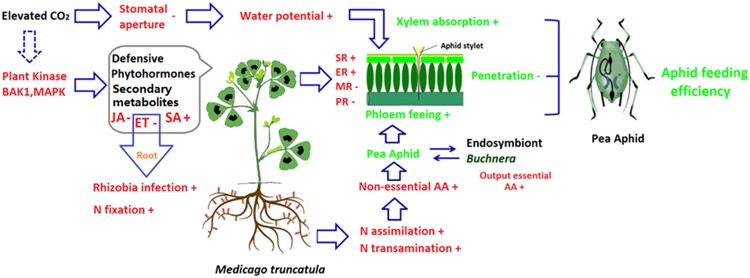FIGURE 1.

Potential effects of elevated CO2 on host plant, and the cascading effects on aphid feeding using Medicago truncatula-pea aphid as examples. Elevated CO2 affects aphid feeding efficiency in three ways. First, elevated CO2 modifies the phytohormone-dependent induced defenses and plant secondary metabolites derived defense. Enhancement of the salicylic acid-dependent defense pathway increased surface and epidermis resistance while the impairment of the jasmonic acid/ethylene-dependent defense pathway decreased mesophyll and phloem resistance. The changes of resistance facilitate the penetration feeding phase (the feeding phase that occurs before the stylet reaches the phloem). Second, the impairment of ethylene signaling pathway enhanced N fixation inroot, elevated CO2 tends to increase N assimilation and non-essential amino acid supple in the phloem. Furthermore, the aphid endosymbiont Buchnera could transform non-essential amino acid into essential amino acids, which increases the output of essential amino acid for aphids. Therefore, the increased amino acid supply benefits the phloem feeding of aphids. Third, elevated CO2 decreases stomatal conductance and transpiration, which increases the water potential in M. truncatula. As a result, aphid xylem feeding and osmotic pressure regulation are enhanced under elevated CO2. These three effects of elevated CO2 (alteration of host plant defenses, of amino acid supply in the phloem, and of host and aphid water status) greatly affect aphid feeding efficiency. AA, amino acid; BAK1, BRI-ASSOCIATED RECEPTOR KINASE 1; ER, epidermis resistance; ET, Ethylene; MAPK, mitogen protein kinases; JA, jasmonic acid; MR, mesophyll resistance; PR, phloem resistance; SA, Salicylic acid; SR, surface resistance; +, positively affected by elevated CO2; -, negatively affected by elevated CO2.
